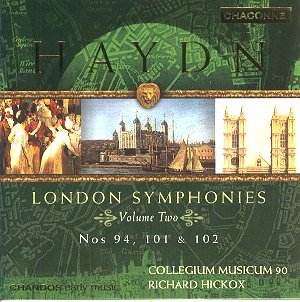Josef HAYDN
Symphonies Nos. 94, 101 & 102
 Collegium Musicum 90/Richard
Hickox
Collegium Musicum 90/Richard
Hickox
 CHANDOS early music CHAN
0662
CHANDOS early music CHAN
0662
Crotchet
AmazonUK
AmazonUS

This disc is Volume 2 of Richard Hickox's recordings of Haydn's "London"
symphonies. It follows on from
Volume 1 which presented
Symphonies 95, 103 ("Drum Roll") and 104 ("London"). Like Volume 1, it contains
one symphony from Haydn's first London visit in 1792 (the "Surprise") and
two from his second visit in 1794-95 (the "Clock" and No.102).
The twelve London symphonies have always been part of the standard concert
repertoire and have been recorded many times. It is legitimate to pose the
question: What is the justification for yet another recording? The superficial
answer is that these symphonies are unfailingly popular and so their recording
is a sure bet for commercial success. The real question is perhaps: Why do
these symphonies attract such persistent devotion from listeners? Like so
much of Haydn's output in the last two decades of his long life ("The Creation",
"The Seasons", the late Masses and the late string quartets), they represent
a quite monumental peak of achievement. Such is their freshness and inventiveness
that their impact never fades, no matter how many repeated performances and
recordings one hears; each new recording and interpretation brings new insights.
The present series of recordings by Hickox with Collegium Musicum is indeed
a welcome addition to the discography.
For these works Collegium Musicum consists of the usual woodwind, brass and
timpani with a string band 8+8+6+4+2. All are period instruments (or replicas
thereof), dating from late 17th to early 19th centuries,
tuned about one quarter-tone below modern philharmonic pitch; the frequencies
are thus perhaps marginally higher than contemporary pitch. Hickox's
interpretations are refreshingly free of artificial mannerisms; the playing
is direct, bright and robust - a quality which brings out in full measure
all the usual hallmarks of late Haydn: Haydn's orchestra remained that of
traditional 18th century; with the single exception of clarinet
parts in Clock Symphony, the instrumentation had hardly changed in 100 years.
Haydn's use of it, however, especially in the contrasts and balance of woodwind
and strings, must, in its day, have been breathtakingly original. (Listen
particularly to the flute and bassoon solos in the Trio sections of the
3rd movement of Symphony No. 101).
Humphrey Smith

